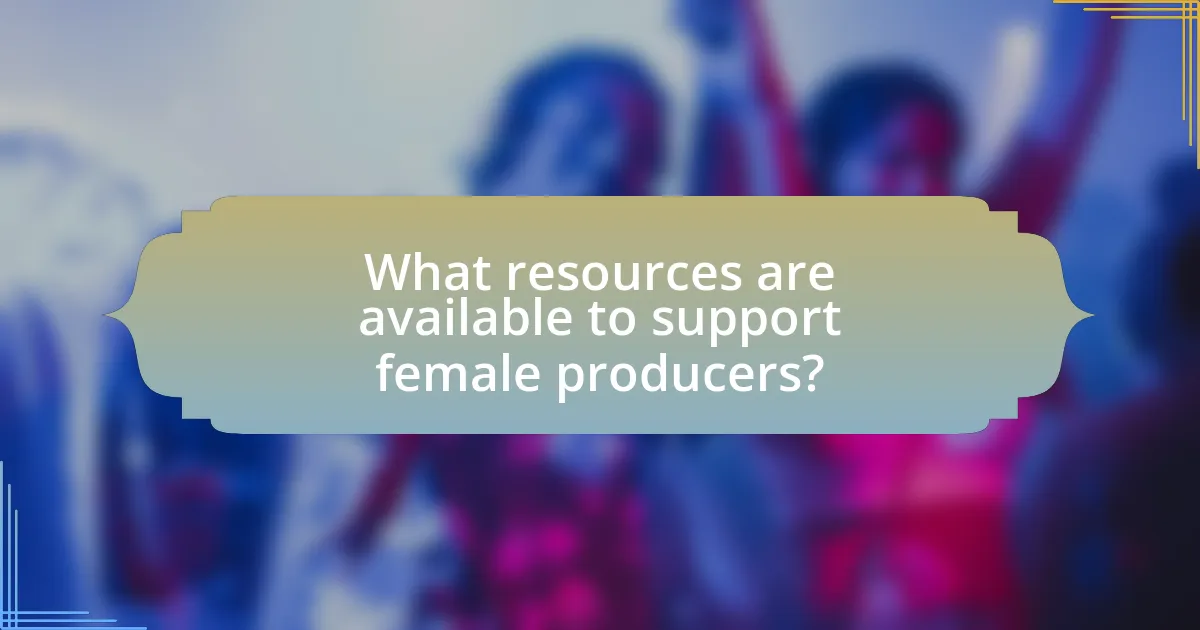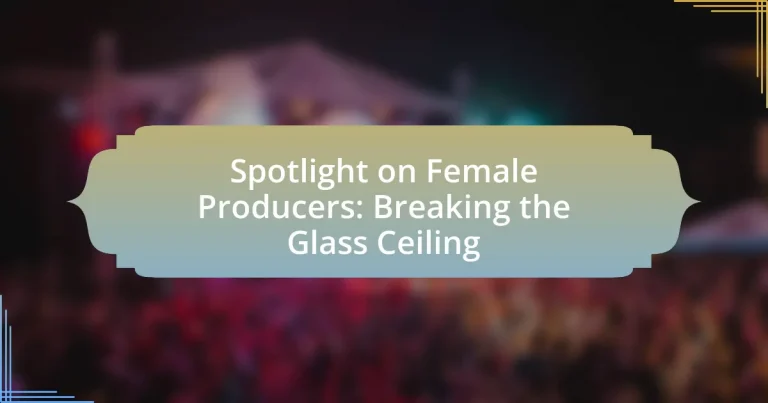The article “Spotlight on Female Producers: Breaking the Glass Ceiling” examines the challenges faced by female producers in the film and television industry, including gender bias, limited access to funding, and underrepresentation in leadership roles. It highlights how societal perceptions and stereotypes impact their career opportunities and the barriers they encounter in hiring practices. The article also discusses the importance of mentorship, networking, and innovative storytelling as strategies for success, while showcasing the positive changes female producers are making in the industry. Additionally, it outlines available resources and funding opportunities to support female-led projects, emphasizing the significant contributions of women in enhancing diversity and representation in media.

What are the challenges faced by female producers in the industry?
Female producers in the industry face significant challenges, including gender bias, limited access to funding, and a lack of representation in leadership roles. Gender bias manifests in the form of stereotypes that question women’s capabilities, often leading to fewer opportunities for female producers compared to their male counterparts. According to a 2021 report by the Annenberg Inclusion Initiative, women accounted for only 16% of directors in the top 100 grossing films, highlighting the systemic barriers they encounter. Additionally, female producers often struggle to secure funding, as studies show that only 2% of venture capital funding goes to female-led projects. This financial disparity limits their ability to produce content and compete effectively in the industry. Furthermore, the underrepresentation of women in executive positions perpetuates a cycle where female voices and perspectives are marginalized, making it difficult for female producers to break through the glass ceiling.
How do societal perceptions impact female producers?
Societal perceptions significantly impact female producers by influencing their opportunities, recognition, and credibility within the industry. These perceptions often stem from traditional gender roles that associate production and leadership with masculinity, leading to biases that can hinder women’s advancement. For instance, a study by the Geena Davis Institute on Gender in Media found that women are underrepresented in key production roles, with only 20% of directors being female, which reflects societal biases that question women’s capabilities in these positions. Additionally, female producers frequently face skepticism regarding their creative decisions, which can undermine their authority and limit their ability to secure funding or support for projects. This systemic bias not only affects individual careers but also perpetuates a cycle that discourages diversity in storytelling and production.
What stereotypes do female producers encounter?
Female producers encounter stereotypes that question their competence and authority in a male-dominated industry. These stereotypes often portray women as less capable of making critical decisions, leading to assumptions that they are only in their roles due to affirmative action or gender quotas. Research from the Geena Davis Institute on Gender in Media highlights that women in production are frequently underestimated, with only 17% of directors being female, reflecting a broader societal bias against women’s leadership in creative fields. Additionally, female producers may face stereotypes that emphasize traditional gender roles, suggesting they should prioritize family over career, which can undermine their professional credibility.
How do these perceptions affect their career opportunities?
Perceptions of female producers significantly limit their career opportunities by reinforcing stereotypes that question their competence and leadership abilities. These biases can lead to fewer job offers, lower pay, and limited access to high-profile projects, as evidenced by a study from the Geena Davis Institute on Gender in Media, which found that women in film and television are often underrepresented in key creative roles. This underrepresentation perpetuates a cycle where women are less likely to be considered for leadership positions, thereby hindering their professional advancement and the diversity of perspectives in the industry.
What barriers exist within the industry for female producers?
Barriers for female producers in the industry include gender bias, lack of access to funding, and limited networking opportunities. Gender bias manifests in hiring practices and project selection, often favoring male counterparts, which is supported by studies indicating that women are underrepresented in leadership roles within production companies. Access to funding is a significant hurdle, as research shows that female-led projects receive a smaller percentage of venture capital compared to male-led initiatives. Additionally, networking opportunities are often skewed, with industry events and informal gatherings predominantly attended by men, limiting women’s ability to form crucial professional connections.
How does gender bias manifest in hiring practices?
Gender bias manifests in hiring practices through the unequal evaluation of candidates based on their gender, often leading to the underrepresentation of women in various industries. Research indicates that women are frequently judged more harshly than men for the same qualifications, with studies showing that resumes with male names receive more favorable responses than identical resumes with female names. For instance, a study published in the Proceedings of the National Academy of Sciences found that male applicants were rated as more competent and hireable than female applicants, despite having identical qualifications. This bias can result in fewer women being hired for leadership roles, perpetuating gender disparities in the workplace.
What role does mentorship play in overcoming these barriers?
Mentorship plays a crucial role in overcoming barriers faced by female producers in the industry. It provides guidance, support, and networking opportunities that are essential for career advancement. Research indicates that women with mentors are more likely to achieve leadership positions and navigate challenges effectively, as mentorship fosters skill development and confidence. For instance, a study by the American Psychological Association found that mentorship significantly enhances career satisfaction and reduces feelings of isolation among women in male-dominated fields. This evidence underscores the importance of mentorship in facilitating the success of female producers and breaking the glass ceiling.

How are female producers breaking the glass ceiling?
Female producers are breaking the glass ceiling by increasing their representation in leadership roles within the film and television industry. According to a 2021 report by the Annenberg Inclusion Initiative, women accounted for 20% of producers in the top 100 grossing films, a significant increase from previous years. This rise is attributed to initiatives promoting gender equality, mentorship programs, and advocacy for diverse storytelling, which empower women to take on more prominent roles in production. Additionally, successful female producers like Shonda Rhimes and Ava DuVernay are setting industry standards and paving the way for future generations, demonstrating that female leadership can lead to both critical and commercial success.
What strategies are successful female producers using?
Successful female producers are leveraging networking, mentorship, and innovative storytelling to advance their careers. Networking allows them to build relationships within the industry, which can lead to collaborative opportunities and increased visibility. Mentorship provides guidance and support from experienced professionals, helping them navigate challenges and develop their skills. Additionally, innovative storytelling enables them to create unique content that resonates with diverse audiences, often addressing underrepresented perspectives. For instance, a study by the Geena Davis Institute on Gender in Media found that films with female producers are more likely to feature strong female characters, highlighting the impact of their storytelling approach.
How do networking and collaboration contribute to their success?
Networking and collaboration significantly contribute to the success of female producers by providing access to resources, opportunities, and support systems. These connections enable female producers to share knowledge, gain mentorship, and collaborate on projects, which enhances their visibility and credibility in the industry. For instance, studies show that women in creative fields who engage in networking are more likely to secure funding and distribution deals, as they can leverage relationships with industry stakeholders. Additionally, collaborative efforts often lead to innovative projects that can attract wider audiences, further solidifying their success in a competitive landscape.
What innovative approaches are female producers taking in their projects?
Female producers are implementing innovative approaches such as collaborative storytelling, leveraging technology for virtual production, and prioritizing diverse narratives in their projects. These strategies enhance creative expression and broaden audience engagement. For instance, female producers are increasingly using platforms like social media to crowdsource funding and feedback, which allows for more inclusive project development. Additionally, studies show that films produced by women often feature more complex female characters and diverse perspectives, reflecting a shift towards more authentic storytelling in the industry.
What impact do female producers have on the industry?
Female producers significantly enhance the industry by promoting diverse narratives and fostering inclusive environments. Their presence leads to a broader representation of stories, as evidenced by the increase in films and television shows that feature female perspectives, which rose by 20% from 2018 to 2020 according to the Geena Davis Institute on Gender in Media. Additionally, female producers often advocate for equitable hiring practices, contributing to a more balanced workforce. This shift not only enriches content but also drives economic growth, as diverse teams have been shown to outperform their counterparts by 35% in profitability, according to McKinsey & Company.
How do their contributions influence storytelling and representation?
Female producers significantly influence storytelling and representation by introducing diverse narratives and perspectives that challenge traditional norms. Their contributions often lead to the creation of content that reflects a broader range of experiences, particularly those of women and underrepresented groups. For instance, the rise of female-led productions has resulted in films and series that prioritize female protagonists and complex character development, as seen in works like “Little Women” produced by Amy Pascal. This shift not only enhances the authenticity of storytelling but also encourages audiences to engage with varied viewpoints, ultimately reshaping cultural narratives and industry standards.
What changes have been observed in industry dynamics due to their presence?
The presence of female producers has led to significant changes in industry dynamics, including increased diversity in storytelling and a shift towards more inclusive production practices. Research indicates that projects led by female producers often prioritize narratives that reflect a broader range of experiences, resulting in content that resonates with diverse audiences. For instance, a study by the Geena Davis Institute on Gender in Media found that films with female producers featured more female characters and complex roles, thereby challenging traditional gender stereotypes. This shift not only enhances representation but also drives economic performance, as diverse teams have been shown to outperform their less diverse counterparts in profitability and innovation.

What resources are available to support female producers?
Female producers can access various resources to support their careers, including grants, mentorship programs, networking organizations, and educational workshops. For instance, the Sundance Institute offers grants specifically for female filmmakers, while organizations like Women in Film provide mentorship and networking opportunities tailored to women in the industry. Additionally, the International Documentary Association has resources and funding specifically aimed at supporting female documentary filmmakers. These resources are designed to empower women in the production field and help them overcome barriers in a traditionally male-dominated industry.
How can aspiring female producers find mentorship and support networks?
Aspiring female producers can find mentorship and support networks by actively engaging with industry organizations and attending networking events specifically designed for women in media. Organizations such as Women in Film, the Alliance of Women Directors, and the International Women’s Media Foundation provide resources, mentorship programs, and networking opportunities tailored for female producers. Additionally, participating in workshops, panels, and film festivals that focus on women’s contributions to the industry can facilitate connections with experienced mentors. Research indicates that women who engage in these networks are more likely to advance in their careers, as mentorship has been shown to significantly impact professional development and opportunities in the film industry.
What organizations focus on empowering female producers?
Organizations that focus on empowering female producers include Women in Film, which advocates for gender parity in the film industry, and the International Women’s Media Foundation, which supports women in media through training and funding. Additionally, the Alliance of Women Directors promotes female directors and producers by providing networking opportunities and resources. These organizations are instrumental in addressing the gender imbalance in the industry and fostering an environment where female producers can thrive.
How can online platforms facilitate connections among female producers?
Online platforms can facilitate connections among female producers by providing dedicated spaces for networking, collaboration, and resource sharing. These platforms, such as social media groups, forums, and professional networks, enable female producers to connect with peers, share experiences, and access mentorship opportunities. For instance, platforms like LinkedIn and Facebook host groups specifically for women in production, allowing members to exchange advice, job leads, and industry insights. Research indicates that women who engage in networking through online platforms report increased career advancement and support, highlighting the effectiveness of these digital spaces in fostering professional relationships.
What funding opportunities exist for female-led projects?
Funding opportunities for female-led projects include grants, venture capital, and crowdfunding specifically aimed at supporting women entrepreneurs. Organizations such as the Amber Grant provide $10,000 monthly grants and a year-end $25,000 grant for women-owned businesses. Additionally, the Female Founders Fund invests in early-stage female-led startups, while platforms like Kickstarter and Indiegogo allow women to raise funds directly from supporters. According to a report by PitchBook, female founders received only 2.3% of venture capital funding in 2020, highlighting the need for targeted funding initiatives to support their projects.
How can female producers access grants and financial support?
Female producers can access grants and financial support through various dedicated funding programs and organizations that focus on supporting women in the industry. For instance, organizations like the Women in Film Foundation and the Sundance Institute offer grants specifically for female filmmakers and producers. Additionally, government initiatives, such as the National Endowment for the Arts in the United States, provide funding opportunities that female producers can apply for. Research indicates that women-led projects receive a smaller percentage of funding, highlighting the importance of these targeted financial resources to promote gender equity in the film industry.
What role do film festivals play in promoting female producers?
Film festivals play a crucial role in promoting female producers by providing a platform for visibility, networking, and recognition. These events often showcase films created by women, allowing female producers to gain exposure to industry professionals and audiences alike. For instance, festivals like the Sundance Film Festival and the Cannes Film Festival have specific initiatives aimed at highlighting female filmmakers, which can lead to increased funding opportunities and collaborations. Additionally, statistics indicate that films directed by women at festivals receive more attention and accolades, further validating the importance of these platforms in advancing women’s roles in the film industry.
What best practices can female producers adopt to thrive in the industry?
Female producers can thrive in the industry by building strong networks, advocating for their work, and continuously developing their skills. Establishing connections with other professionals can lead to collaboration opportunities and mentorship, which are crucial for career advancement. Actively promoting their projects through social media and industry events enhances visibility and recognition. Furthermore, engaging in ongoing education, such as workshops and industry seminars, allows female producers to stay updated on trends and technologies, thereby increasing their competitiveness. According to a study by the Center for the Study of Women in Television and Film, female producers who network effectively and seek mentorship are more likely to secure funding and project opportunities.
How can female producers effectively market their projects?
Female producers can effectively market their projects by leveraging social media platforms, building strong networks, and utilizing targeted marketing strategies. Social media allows female producers to showcase their work, engage with audiences, and create buzz around their projects, as evidenced by the success of campaigns like #WomenInFilm, which has increased visibility for female-led projects. Additionally, networking with industry professionals can lead to collaborations and opportunities that enhance project visibility. Targeted marketing strategies, such as identifying niche audiences and using data analytics, can help female producers reach the right viewers, as demonstrated by the rise of independent films that successfully connect with specific demographics through tailored marketing efforts.
What skills should female producers focus on developing for career advancement?
Female producers should focus on developing leadership, negotiation, and technical skills for career advancement. Leadership skills enable female producers to effectively manage teams and projects, fostering a collaborative environment that enhances productivity. Negotiation skills are crucial for securing better deals and advocating for their projects, which can lead to increased funding and resources. Technical skills, including proficiency in industry-standard software and understanding production processes, are essential for staying competitive in a rapidly evolving field. According to a report by the Producers Guild of America, women in leadership roles significantly improve project outcomes, highlighting the importance of these skills in advancing careers in production.





